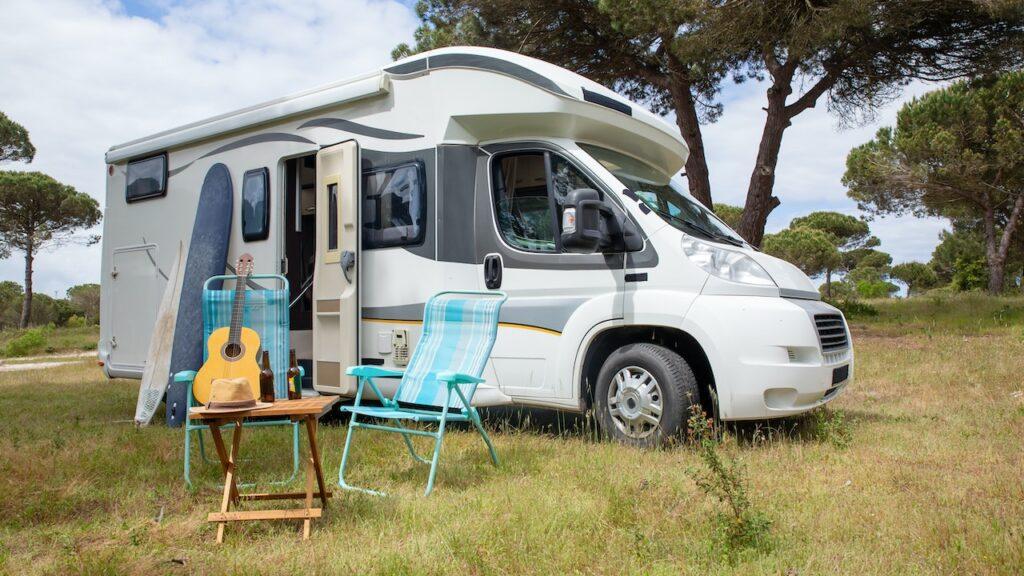Do you know how a sticky, damp RV can ruin your day? Finding the best RV dehumidifier is the solution to keep your living space comfortable and your belongings safe from mold and mildew. In this guide, we ranked and reviewed the 9 best RV dehumidifiers for van life adventure in 2025, so you can pick the right one for you.
We’re reader-supported. When you buy through links on our site, we may earn an affiliate commission. As an Amazon Associate, we earn from qualifying purchases.
Our Top 9 Picks of Best RV Dehumidifiers for Van Life
- Best Overall Option: TABYIK Dehumidifier
- Value for Money Option: Pro Breeze Dehumidifier
- Energy Efficient Option: SANVINDER Dehumidifiers
- Best Multi-Functional Option: Eva-Dry Whisper-Quiet EDV-1100 Dehumidifier
- Auto Shut-Off Option: BREEZOME 60 OZ Dehumidifiers
- Touch Adjustable Option: Tenergy Sorbi 1000ml Air Dehumidifier
- Ease To Use Option: AlohaAir Dehumidifiers
- Small Van Option: Eva-Dry E-500 Renewable Dehumidifier
- Large Van Option: ToLife Dehumidifiers
What is the Best RV Dehumidifier for Camper Van Living?
The best RV dehumidifier for camper van living depends on your specific needs, like space, humidity levels, and power options. Compact, energy-efficient, and quiet models often work best for small spaces like camper vans. Here are the top dehumidifiers for van life:
1. Best Overall Option: TABYIK Dehumidifier

Quick Specifications
- Brand: TABYIK
- Water Tank Capacity: 1000 Milliliters
- Size: 5.9″D x 5.9″W x 10.1″H
- Weight: 2.19 pounds
- Mode: Sleep-Friendly
- Air Flow: 800 Milliliters
- Maximum Operating Temperature: 95 Degrees Fahrenheit
- Key Features: Portable, Whisper-Quiet, Automatic Shutoff, Ambient LED Light
We’ve personally tested the TABYIK 35 OZ Dehumidifier and are genuinely impressed by its prowess. It’s a powerhouse in small spaces, adeptly keeping RV interiors dry and comfortable. With a modest energy footprint, it’s a guilt-free solution for persistent humidity. Its daily dehumidifying capacity, at 0.45 liters, is quite effective for its size.
It’s the additional touches that set this unit apart. The softly glowing LED light creates a cozy atmosphere, a rare find in dehumidifiers. Its whisper-quiet operation is a godsend, especially for light sleepers or those working from their RV. The transparent tank, easily detachable, makes monitoring and maintenance a breeze.
Pros
- Exceptionally effective in small, humid environments, perfect for RVs.
- Consumes minimal energy, making it economical for regular use.
- Operates quietly, ensuring undisturbed sleep or work.
- The transparent tank allows for easy water level monitoring and maintenance.
Cons
- May not be sufficient for larger RVs or extremely humid conditions.
- The tank might need frequent emptying in high humidity environments.
The TABYIK 35 OZ Small Dehumidifier is our top choice for its efficient moisture control, user-friendly design, and additional ambient lighting feature. Its compact size and convenient carry handle make it a versatile and welcome addition to any RV. Safety features like the automatic shut-off are reassuring, especially for those who travel often. this dehumidifier is truly an outstanding choice for those seeking to elevate their RV adventures with a cozy, humidity-free atmosphere.
2. Value for Money Option: Pro Breeze Dehumidifier
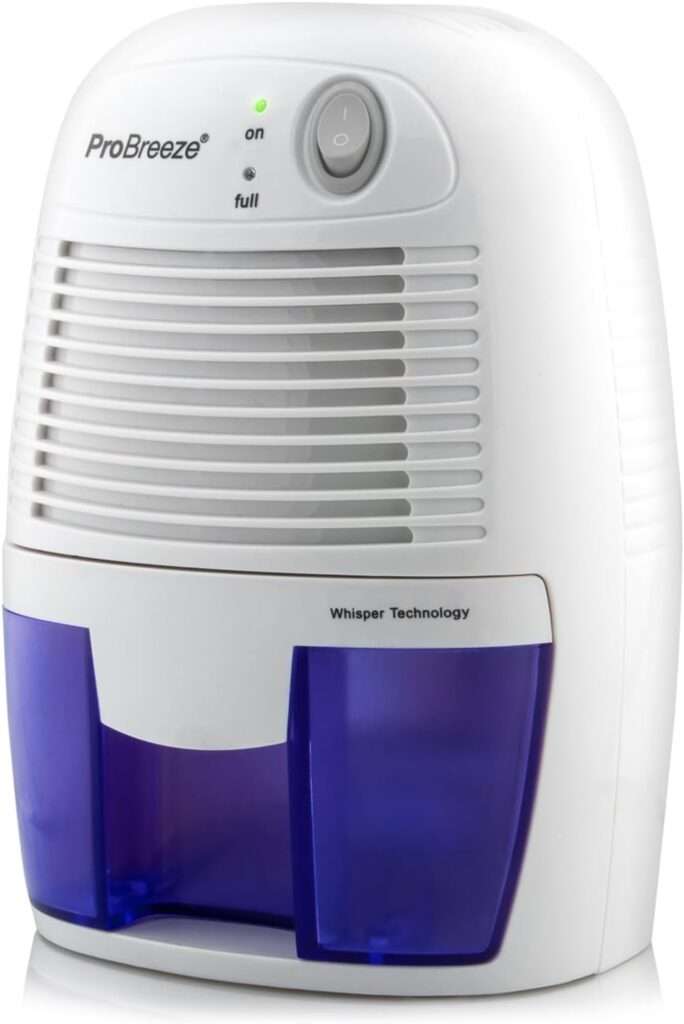
Quick Specifications
- Brand: Pro Breeze
- Coverage Area: Up to 215 Square Feet
- Features: Auto Shut-Off, LED Indicator, Compact, Energy Efficient
- Capacity: 16 Ounces
- Dimensions: 6″D x 6″W x 8.5″H
- Included: DC Adapter, Instruction Manual
- Weight: 2.4 Pounds
- Wattage: 23 Watts
After testing the Pro Breeze Dehumidifier in our RV, we found it to be an exceptional match for smaller spaces. It efficiently covers areas up to 215 square feet, perfect for RV bedrooms or bathrooms. This dehumidifier’s standout feature is its ability to draw up to 9 ounces of moisture daily, with a manageable 16-ounce tank.
Moreover, its ultra-quiet operation is a real game-changer, especially for those of us who prefer a serene environment. This, coupled with its energy efficiency – only 23 watts per hour – makes it a pocket-friendly choice for continuous use. The automatic shut-off feature when the tank fills is a thoughtful addition, ensuring peace of mind and safety.
Pros
- Perfectly sized for small RV spaces, making it highly versatile.
- Ultra-quiet, ensuring a peaceful atmosphere in your RV.
- Energy-efficient, reducing power consumption and costs.
- Convenient auto shut-off feature for added safety and ease of use.
Cons
- Limited effectiveness in larger or very humid RV areas.
- Not suitable for use in colder conditions below 41°F.
In our opinion in essence, the Pro Breeze Dehumidifier is the go-to budget-friendly choice for RV enthusiasts on our list. It’s a compact, yet powerful tool for tackling humidity in smaller areas. Given its low energy consumption and effective moisture removal, it offers excellent value for money. For those managing humidity on a budget, this dehumidifier is undoubtedly the right pick.
3. Energy Efficient Option: SANVINDER Dehumidifiers
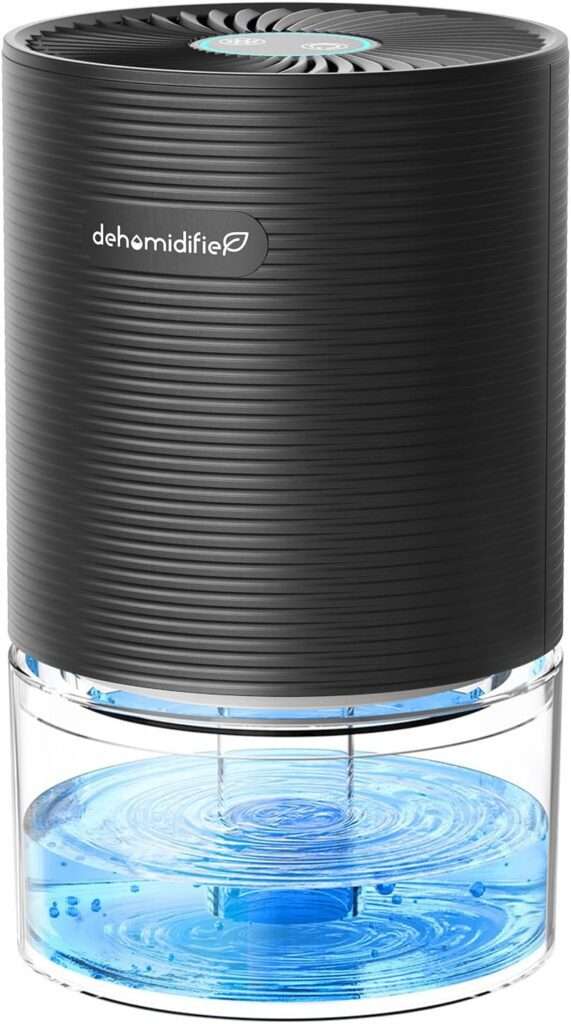
Quick Specifications
- Brand: SANVINDER
- Coverage Area: 285 square feet
- Features: Nightlight, Quiet, Auto-off
- Capacity: 750 milliliters (25 fluid ounces)
- Dimensions: 5.03″D x 5.03″W x 8.38″H
- Included: User manual, adapter, dehumidifier
- Weight: 2.2 pounds
- Wattage: 23 watts
From our perspective, the SANVINDER Dehumidifier offers a perfect blend of portability and performance. It’s small enough to fit anywhere in your RV yet powerful enough to remove moisture effectively. The quiet operation is a standout feature, making it ideal for sleeping or working environments.
Additionally, the user-friendly design includes an auto-off function to prevent overflows, adding to its convenience. The built-in nightlight adds subtle illumination, which we found helpful without being distracting. It’s an efficient, hassle-free way to keep your space dry and comfortable.
Pros
- Effective moisture removal for small spaces
- Ultra-quiet operation for minimal disturbance
- Compact and lightweight design for easy placement
- Energy-efficient, using minimal power
Cons
- Water tank needs frequent emptying in humid conditions
- Best suited for smaller areas
The SANVINDER Dehumidifier is an excellent option for RV owners needing an efficient, quiet, and compact solution for humidity control. Its blend of energy efficiency, thoughtful features, and portability makes it a practical choice for maintaining comfort in your RV. It’s a reliable companion for any road trip or adventure.
4. Best Multi-Functional Option: Eva-Dry Whisper-Quiet EDV-1100 Dehumidifier
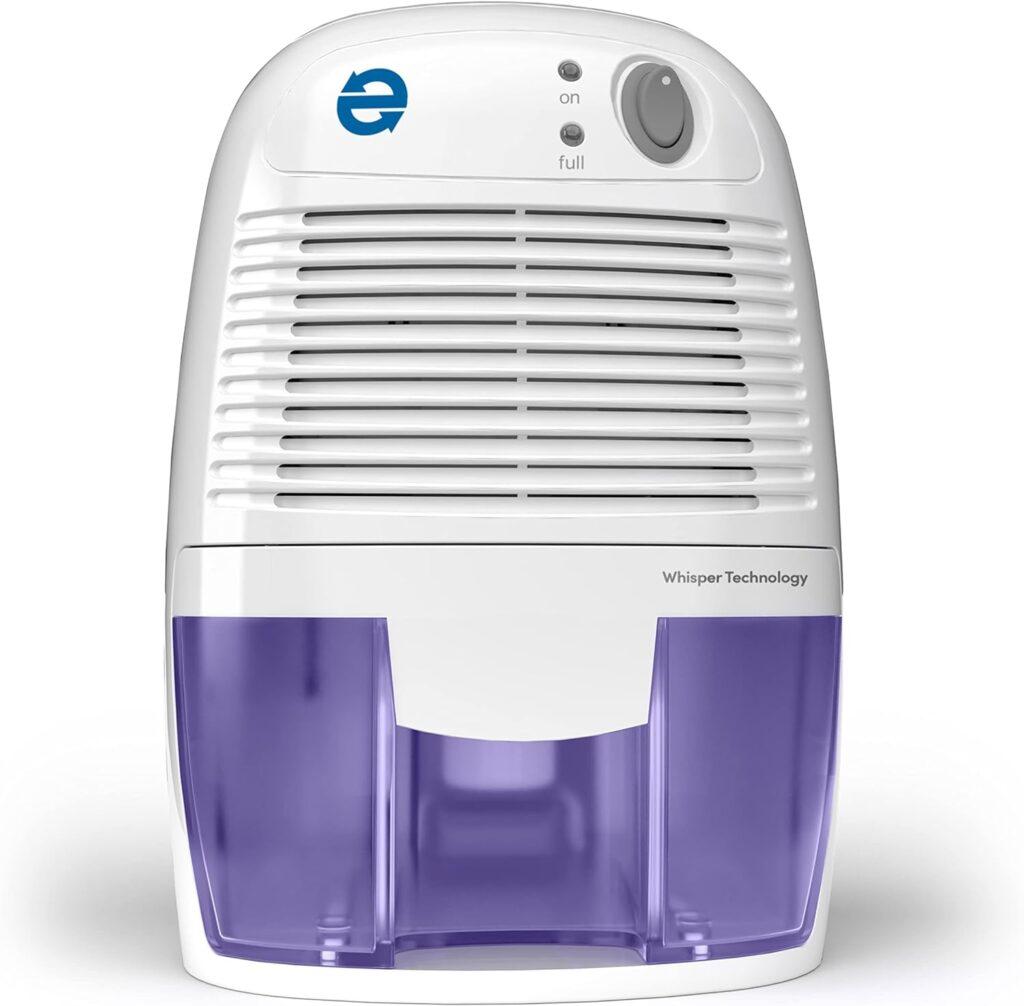
Quick Specifications
- Brand: Eva-Dry
- Capacity: 8 Ounces (16 oz. Reservoir Tank)
- Size: 5.3″D x 6.5″W x 11″H
- Includes: Power Adapter, Power Cord, Dehumidifier
- Power Use: 22 watts
- Air Flow: 300 CFPH
- Maximum Operating Temperature: 105 Degrees Fahrenheit
- Key Features: Auto Restart, Quiet Operation, Automatic Moisture Removal, Auto Shutoff
The Eva-Dry EDV-1100 Dehumidifier emerged as a standout choice for RV owners seeking value and efficiency. Its petite size belies its impressive ability to remove moisture in spaces up to 122 square feet, making it perfect for smaller RVs or specific areas like bathrooms and closets. We were particularly impressed with its performance in higher humidity conditions, efficiently collecting up to 8 oz. of moisture per day.
Moreover, its whisper-quiet operation is a significant advantage for those who value a tranquil environment. The noise level, measured at a mere 33 dB, is remarkably lower than the average for similar devices. This feature ensures a disturbance-free night’s sleep or a quiet workspace. Additionally, the auto shut-off function adds a layer of safety and convenience, especially when you’re away.
Pros
- Highly effective in small spaces, ideal for compact RVs.
- Extremely quiet operation, enhancing overall comfort.
- Auto shut-off feature ensures safety and convenience.
- Portable and easy to use in various settings within the RV.
Cons
- May not be as effective in larger RV spaces or extremely humid conditions.
- Lacks a continuous drain option, requiring manual tank emptying.
The Eva-Dry EDV-1100 is a top pick for those seeking a dehumidifier that offers great value. It’s easy to set up and operate, making it a practical choice for RV enthusiasts. Its ability to restart automatically after a power interruption adds to its appeal, ensuring continuous operation. Considering its features, efficiency, and price point, it stands out as the proper value dehumidifier for RVs, especially for those with smaller spaces and specific humidity control needs.
5. Auto Shut-Off Option: BREEZOME 60 OZ Dehumidifiers
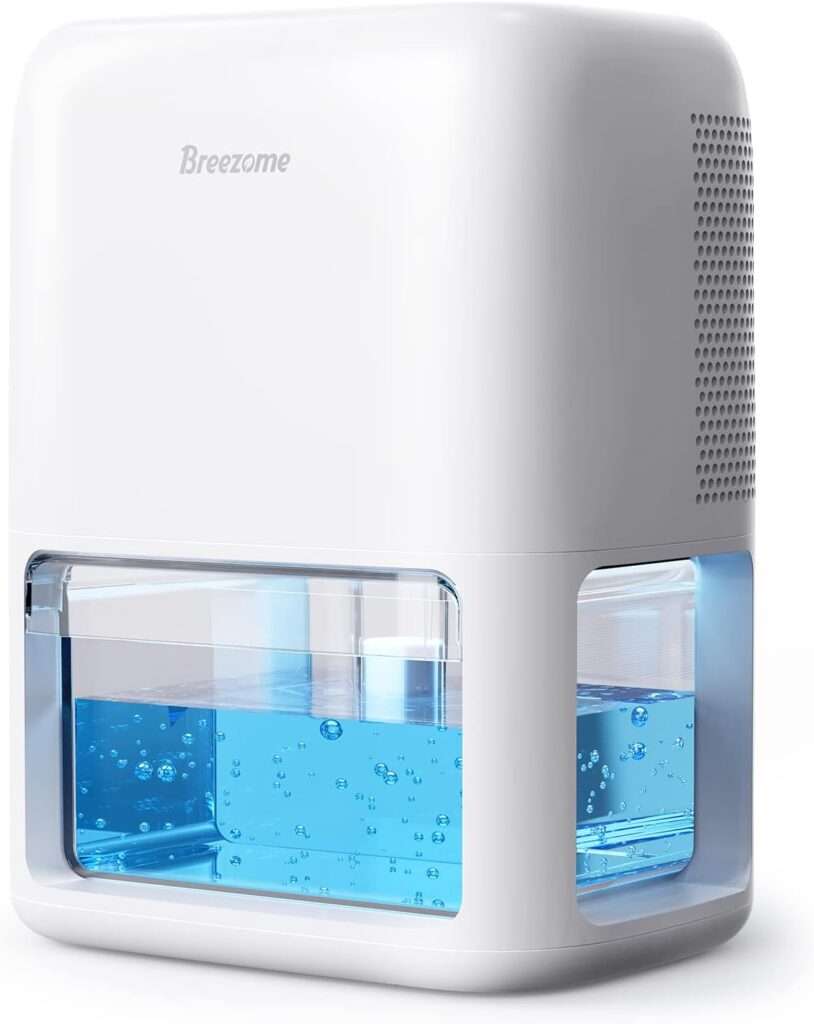
Quick Specifications
- Brand: BREEZOME
- Coverage Area: 250 square feet
- Features: Dual Semiconductor Condensers, Portable, Auto Defrost
- Capacity: 1.8 liters (60 ounces)
- Tank Volume: 1800 milliliters
- Dimensions: 6.26″D x 8.62″W x 11.34″H
- Included: 1 dehumidifier
- Weight: 3.74 pounds
- Wattage: 48 watts
From our standpoint, the BREEZOME 60 OZ Dehumidifier combines convenience and efficiency, making it a great choice for RVs and other small spaces. Its compact design, paired with a built-in handle, ensures effortless portability, while the 1.8L tank capacity minimizes frequent emptying, even in humid environments. We also appreciate the defrost function, which keeps it operating smoothly in varying conditions.
What sets it apart is the dual operation modes. The quiet sleep mode is perfect for nighttime use, maintaining a serene atmosphere at just 35dB. Plus, the adjustable nightlight with color options creates a cozy vibe. The timer feature is another highlight, allowing you to set specific operation times to avoid unnecessary energy use.
Pros
- Large water tank reduces the need for frequent emptying
- Compact and portable with a built-in handle
- Quiet sleep mode for nighttime use
- Timer function to save energy
Cons
- Limited to spaces up to 250 square feet
- Nightlight brightness might not suit everyone
From our perspective, the BREEZOME Dehumidifier is a well-rounded solution for small spaces like RVs or bedrooms. Its energy efficiency, thoughtful features like the timer and defrost function, and quiet operation make it an excellent choice for maintaining comfort without hassle. It’s reliable, practical, and easy to use for everyday needs.
6. Touch Adjustable Option: Tenergy Sorbi 1000ml Air Dehumidifier
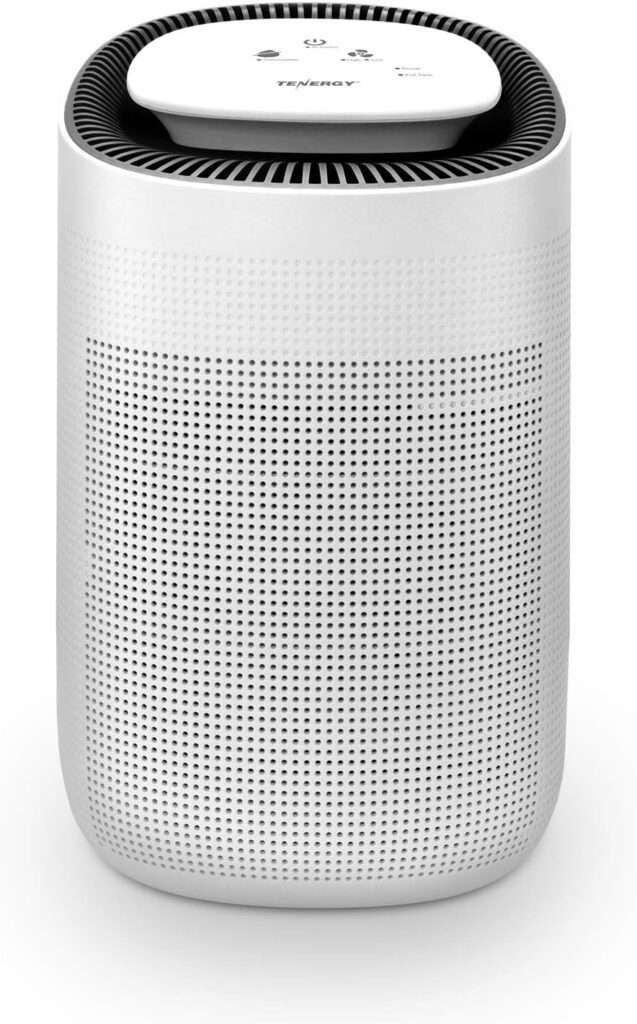
Quick Specifications
- Brand: Tenergy
- Coverage Area: 200 square feet
- Features: Programmable, True HEPA filter, Auto shut-off
- Capacity: 1000 milliliters (1 liter)
- Tank Volume: 1000 milliliters
- Dimensions: 7.7″D x 8.5″W x 12″H
- Included: Air dehumidifier, HEPA filter
- Weight: 6 pounds
- Wattage: 45 watts
From our standpoint, the Tenergy Sorbi Dehumidifier stands out as an ideal choice for those who need both moisture control and cleaner air. Its compact design fits easily in small spaces like bathrooms, offices, or closets, while the combination of a dehumidifier and a true HEPA filter ensures a more comfortable and healthier living environment. The Peltier technology makes it efficient and quiet, so you can enjoy dry, clean air without disturbing your activities.
We also value the added touch control and programmable features, which make it incredibly easy to operate. The auto shut-off and water level indicator provide extra convenience, ensuring no spills even when the tank is full. Its ultra-quiet operation and certified safety standards make it a reliable choice for everyday use.
Pros
- Combines dehumidification and air purification in one unit
- True HEPA filter removes 99.97% of particulates
- Compact and lightweight for small spaces
- Quiet operation with programmable settings
Cons
- Best suited for areas up to 200 square feet
- Water tank may require frequent emptying in high humidity
From our perspective, the Tenergy Sorbi is an excellent multifunctional option for anyone looking to control humidity and improve air quality simultaneously. Its compact size, advanced HEPA filtration, and user-friendly features make it an efficient and practical solution for small living spaces. Whether it’s a bathroom, closet, or home office, this dehumidifier is a reliable choice for maintaining a comfortable environment.
7. Ease To Use Option: AlohaAir Dehumidifiers
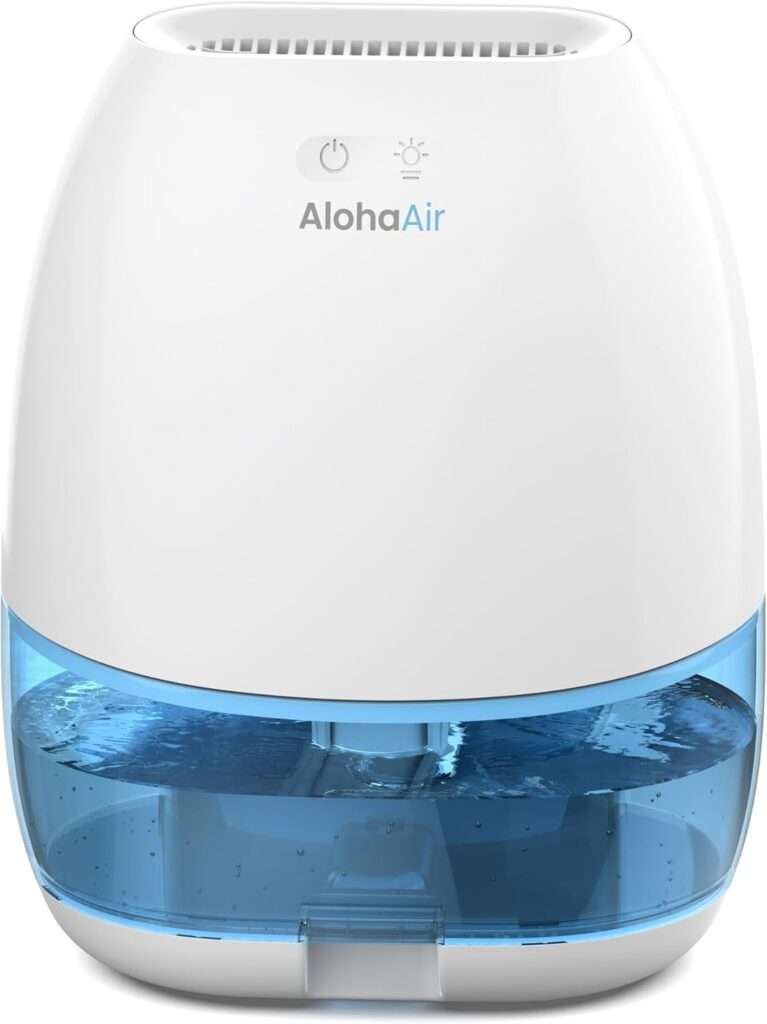
Quick Specifications
- Brand: AlohaAir
- Coverage Area: 200 square feet
- Features: Portable, Quiet Operation, Automatic Shutoff
- Capacity: 2.1 pounds
- Tank Volume: 34 fluid ounces
- Dimensions: 5.51″D x 8.66″W x 11.22″H
- Weight: 2.19 pounds
- Wattage: 40 watts
From our standpoint, the AlohaAir Dehumidifier is an excellent choice for small spaces like bedrooms, bathrooms, or RVs. Its compact design, combined with a built-in handle, makes it easy to move around wherever it’s needed. Despite its small size, it delivers efficient moisture removal, handling up to 280ml of water per day while consuming minimal energy.
We especially appreciate the thoughtful design of the transparent 34-ounce water tank, which makes it simple to monitor and empty. The auto shut-off feature adds peace of mind by preventing spills, and the quiet operation ensures it won’t disrupt your sleep. Additionally, the 7-color night light adds a charming touch to any space, enhancing the overall experience.
Pros
- Compact and portable with a built-in handle
- Transparent tank for easy water monitoring
- Auto shut-off feature for safety
- Quiet operation with 7-color night light
Cons
- Limited to smaller spaces up to 200 square feet
- Slower moisture removal in very humid conditions
From our perspective, the AlohaAir Dehumidifier combines portability, efficiency, and convenience in a small, user-friendly package. Its quiet operation, colorful night light, and reliable moisture removal make it a practical solution for maintaining comfort in smaller spaces. Whether for an RV or a cozy bedroom, this dehumidifier is a smart and stylish choice.
8. Small Van Option: Eva-Dry E-500 Renewable Dehumidifier

Quick Specifications
- Brand: Eva-Dry
- Effective Area: Up to 500 Square Feet
- Special Feature: Portable and Renewable
- Capacity: 8 Ounces
- Dimensions: 2.5″D x 8″W x 6″H
- Weight: 4.32 Pounds each
- Wattage for Recharging: 22 Watts
- Air Flow: 6 Ounces
- Maximum Temperature Tolerance: 105°F
We recently explored the Eva-Dry E-500 Dehumidifier for our RV’s smaller areas. This compact device is a game-changer for managing humidity in confined spaces. Utilizing crystallized silica gel technology, it impressively absorbs moisture, safeguarding against dampness.
Moreover, the E-500’s renewable aspect is a standout feature. Easily recharged by plugging in for 12-14 hours, it’s ready for action again, blending eco-friendliness with convenience. The visual moisture indicator, transitioning from orange to green, is a handy cue for recharging. Additionally, its silent operation ensures your peace and quiet remains undisturbed.
Pros
- Excellently suited for smaller RV spaces, efficiently managing moisture.
- Eco-friendly and renewable, with a simple recharging process.
- Silently operates, maintaining a tranquil environment.
- Visual moisture indicator simplifies monitoring and maintenance.
Cons
- Frequent recharging may be needed in highly humid conditions.
- Not ideal for larger areas or extremely damp environments.
The Eva-Dry E-500 is a top-notch option for dehumidifying smaller RV spaces. Its innovative, eco-friendly technology, combined with effective moisture control, makes it an exemplary choice. For those with compact RV areas looking for a sustainable and efficient dehumidifier, the Eva-Dry E-500 is undoubtedly a smart pick.
9. Large Van Option: ToLife Dehumidifiers
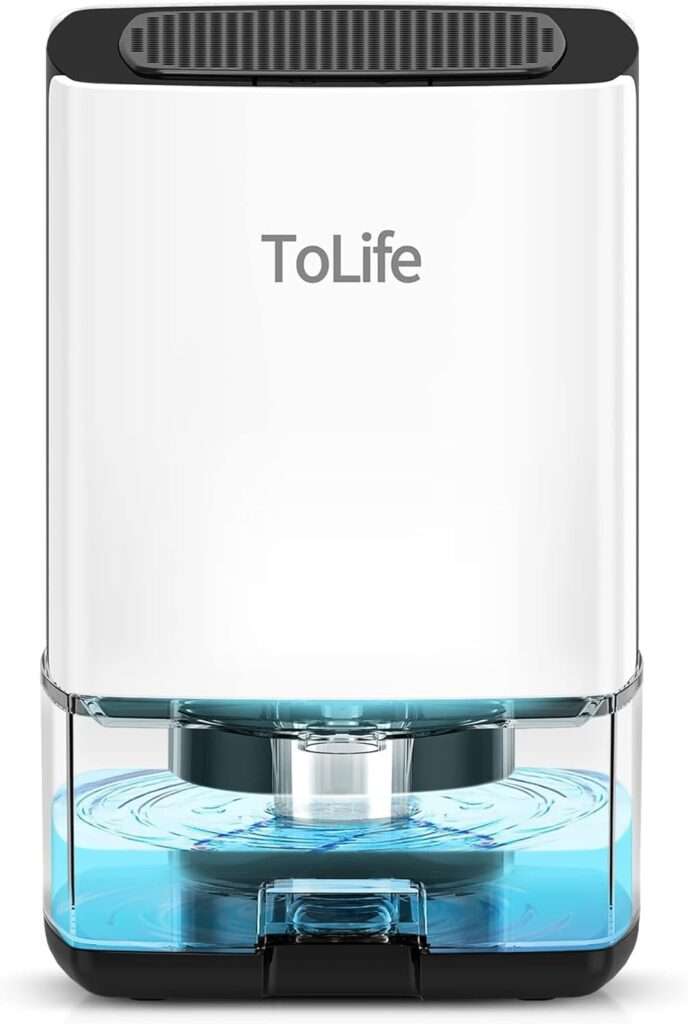
Quick Specifications
- Brand: ToLife
- Features: Portable, Quiet, Removable Tank, Auto Shutoff, Washable Filter
- Dimensions: 6.14″D x 6.14″W x 9.37″H
- Weight: 2.93 Pounds
- Operation Mode: Comfort
- Air Flow: 3 ml/min
- Max Temperature Tolerance: 104°F
We recently integrated the ToLife Dehumidifier into our larger RV spaces and were impressed with its performance. This device handles the challenge of maintaining ideal humidity levels in larger areas with ease. It uses advanced semiconductor condensation technology, which efficiently extracts moisture, ensuring the environment stays comfortably below 45% humidity.
Furthermore, the ToLife Dehumidifier stands out with its user-friendly design and aesthetic appeal. The automatic shutdown feature, activated when the tank is full, is accompanied by a warning sound and a flashing red light, ensuring safety and convenience. The addition of 7 colorful lights brings a unique and pleasant ambiance to any space. Its silent operation mode is a significant benefit, promoting a restful night’s sleep without the disturbance of noise.
Pros
- Effectively manages humidity in large RV spaces.
- User-friendly with simple operational buttons and a washable filter.
- Adds aesthetic appeal with 7 colorful LED lights.
- Silent operation ensures a peaceful environment.
Cons
- The 800ml capacity may require frequent emptying in highly humid conditions.
- Relatively small tank size for its coverage area.
The ToLife Dehumidifier is an excellent choice for those with larger RV spaces needing effective humidity control. Its combination of efficiency, ease of use, and additional features like colorful LED lighting makes it stand out. For RV owners seeking a balance of functionality, convenience, and a touch of style, this dehumidifier is the right pick in its category.
How We Tested the Dehumidifiers
As RV enthusiasts ourselves, we’ve had firsthand experience using many of these dehumidifiers during our adventures. We understand the challenges of van life, from humid mornings in the mountains to coastal trips with sticky air.
But we didn’t stop there. We reached out to fellow RVers, friends, and colleagues who shared their honest opinions about what worked (and what didn’t) for them. Their insights helped refine our list further.
Finally, we scoured hundreds of online reviews to uncover real-world feedback from other users. We wanted to save you the hassle of endless research so you can focus on finding the perfect fit for your RV.
Why Is Humidity Inside an RV a Problem?
Excess humidity in an RV can lead to mold, mildew, and long-term damage to your vehicle’s interior. It also makes your living space feel uncomfortable and can even trigger allergies or respiratory issues.
When moisture lingers, it seeps into fabrics, wood, and walls, creating the perfect breeding ground for mold. Over time, this can damage your RV’s structure and ruin furniture.
Plus, high humidity can make the air feel heavier, adding to the discomfort of small spaces. Keeping humidity in check isn’t just about comfort—it’s about protecting your RV investment and your health.
What Are the Benefits of Using a Dehumidifier for Your RV?
Using a dehumidifier can transform your RV experience by eliminating the hassles of excess moisture. Here’s why it’s worth considering:
- Prevents Mold and Mildew: Keeps your walls, furniture, and storage areas mold-free.
- Improves Air Quality: Removes dampness, reducing odors and allergens.
- Protects Your RV’s Interior: Prevents warping of wood and corrosion of metal parts.
- Enhances Comfort: Creates a fresh, dry, and cozy environment inside your RV.
- Saves Money Long-Term: Protects against costly repairs caused by water damage.
Types of Dehumidifiers for RVs
There’s no one-size-fits-all when it comes to RV dehumidifiers. Each type has its own strengths, so let’s break them down to help you decide which fits your lifestyle.
Compressor-Based Dehumidifiers
These are the heavy lifters of the dehumidifier world. They pull moisture out of the air using a refrigeration process, making them ideal for tackling high humidity levels in larger RVs. If you’ve ever been parked near a lake or in a rainy area, you know how quickly moisture can build up—and this type can handle it.
The trade-offs? They can be a little noisy and bulky, so you’ll want to consider where you’ll store it when not in use. But for full-time RVers or anyone battling consistent moisture issues, a compressor-based model is a reliable choice.
Desiccant Dehumidifiers
If you’re RVing in colder climates, desiccant dehumidifiers shine. Unlike compressor models, they use a moisture-absorbing material to get the job done. These units are lighter, quieter, and more portable, making them great for smaller RVs or those traveling to chilly destinations.
On the flip side, they’re typically less efficient at removing large amounts of moisture in warm or very humid conditions. They also consume more power, so they might not be ideal for off-grid setups.
Thermoelectric (Peltier) Dehumidifiers
Compact and energy-efficient, thermoelectric dehumidifiers are perfect for small RVs or van lifers who need something that won’t hog space. They work using a small cooling plate and are nearly silent, which is a big win if you’re sensitive to noise or plan to use it while you sleep.
However, don’t expect these to handle a flood of moisture. They’re best suited for mild humidity and smaller spaces like bathrooms or sleeping areas. Think of them as the lightweight option for occasional use.
Rechargeable Mini Dehumidifiers
These little guys are lifesavers for specific spots like closets, drawers, or storage compartments. Rechargeable mini dehumidifiers are wireless and easy to move around. Most use silica gel that changes color to indicate when it’s time to recharge, making them super user-friendly.
They’re not designed for large-scale moisture removal, but they’re a fantastic addition if you’re dealing with musty odors or condensation in smaller areas. Plus, they’re a low-power option for van life.
How to Choose the Best Dehumidifier for Your RV
Picking the right dehumidifier can feel like choosing the perfect campsite—lots of options, but the right one makes all the difference. Here’s what to think about:
Capacity
Capacity matters because it determines how much moisture the dehumidifier can remove in a day. If you have a smaller RV or only deal with mild humidity, a compact model with lower capacity might work fine.
But for larger RVs or areas with persistent moisture, you’ll need something high-capacity that can keep up. Check the specs—most are listed as “pints per day” or “liters per day.”
Portability
RV life is all about being flexible, and your dehumidifier should be, too. Look for one that’s lightweight and easy to carry. Some models have handles or wheels, which can be a game-changer when you need to move it from one area to another.
Energy Efficiency
Running a dehumidifier on the road means balancing comfort with power consumption. For those relying on solar power or batteries, energy-efficient RV dehumidifiers are the way to go. Look for models with an Energy Star rating or ones specifically marketed for low-power operation.
Noise Levels
Nobody wants a noisy machine humming away while they’re trying to relax or sleep. Quiet RV dehumidifiers are especially important for small spaces where sound carries. Look for decibel ratings in the product specs or reviews—lower is better if peace and quiet are a priority.
Drainage Options
This might seem small, but it makes a big difference in day-to-day use. Some models come with tanks you’ll need to empty manually. That’s fine for occasional use, but if you’re battling constant humidity, continuous drainage (via a hose) is a time-saver. Check if the model includes the hose or if you’ll need to purchase one separately.
Additional Features
Modern dehumidifiers often come with helpful extras like auto shut-off (to prevent overflow), built-in humidity sensors, or digital displays for easy monitoring. While not essential, these features can make your life easier, especially if you want to set it and forget it.
Setting Up and Using an RV Dehumidifier
How can you set up and use an RV dehumidifier effectively? It’s easier than you think! With the right placement and a few simple steps, you’ll maximize your dehumidifier’s performance and enjoy a drier, more comfortable RV environment.
Here’s how to get started:
- Choose the Right Spot: Place your dehumidifier where moisture builds up the most, like near windows, in the bathroom, or close to the kitchen. Ensure there’s enough space around it for airflow.
- Check the Power Source: Use a model compatible with your RV’s power setup, whether that’s shore power, a generator, or solar energy.
- Set the Humidity Level: If your dehumidifier has a built-in humidity sensor, set it to maintain a comfortable level (around 30–50%).
- Monitor the Tank or Hose: For units with tanks, empty them regularly to prevent overflow. If you’re using continuous drainage, ensure the hose is securely connected and draining properly.
- Run it at the Right Time: Use the dehumidifier when humidity levels are highest, like after cooking, showering, or during damp weather.
How to Maintain Your RV Dehumidifier
Regular maintenance is key. It not only ensures your dehumidifier works efficiently but also prevents issues like mold buildup.
Here’s what you should do:
- Clean the Filter: Most dehumidifiers have washable or replaceable filters. Clean them every 2–4 weeks to keep the air fresh and the unit efficient.
- Empty and Clean the Tank: If your model has a water tank, empty it daily or as needed. Wash the tank with mild soap and water to prevent mold and bacteria.
- Inspect the Hose: For units with continuous drainage, check the hose for clogs or leaks and clean it periodically.
- Wipe the Exterior: Dust and dirt can collect on the unit. Use a damp cloth to clean the exterior and vents occasionally.
- Check for Strange Noises: If your dehumidifier starts making unusual sounds, it might need troubleshooting. Check the manual or contact the manufacturer if needed.
- Store it Properly: If you’re not using the dehumidifier during the off-season, clean it thoroughly and store it in a dry place to prevent damage.
With these tips, your dehumidifier will stay in great shape, keeping your RV comfortable and moisture-free for all your adventures!
Final Words
Keeping your RV free from excess humidity isn’t just about comfort—it’s about protecting your home on wheels from mold, mildew, and costly damage. Whether you’re a weekend warrior or living full-time on the road, choosing the right dehumidifier can make all the difference.
For those looking for a small but mighty solution, the TABYIK 35 OZ Dehumidifier is perfect for compact spaces, offering whisper-quiet operation and portability.
If you’re on a budget but still need effective performance, the Pro Breeze Dehumidifier delivers excellent moisture control for smaller RV areas without breaking the bank.
And for those with larger RVs or higher humidity levels, the ToLife Dehumidifier is a standout option, combining efficiency with user-friendly features.
With the right dehumidifier, you can enjoy a fresh, dry, and comfortable RV environment no matter where your travels take you. Safe and happy adventuring!
FAQs
How do I know what size dehumidifier I need for my RV?
It depends on your RV’s size and humidity levels. For small RVs or mild humidity, a compact dehumidifier should suffice. For larger RVs or very damp conditions, look for a higher-capacity model (measured in pints or liters per day).
Can I use a home dehumidifier in my RV?
Yes, but keep in mind that home dehumidifiers are often larger, heavier, and consume more power. If space or energy is limited, opt for a portable or RV-specific model for better convenience and efficiency.
How often should I empty the tank or clean the unit?
This depends on the humidity level and the size of the tank. In high humidity, you may need to empty the tank daily or even multiple times a day. Cleaning the tank and filter every 2–4 weeks helps maintain efficiency and hygiene.
Is it safe to leave the dehumidifier running overnight?
Yes, most modern dehumidifiers have safety features like auto shut-off when the tank is full. Just ensure it’s placed securely and away from any hazards, and use a model designed for continuous or long-term operation if needed.
As outdoor enthusiasts ourselves, we understand the significance of reliable gear that can withstand the elements and support you throughout your journey. We try to provide as much real life information with our guides and how tos to the readers as possible. Our honest and transparent reviews of essential outdoor gadgets and products are rooted in testing and experience. We take great satisfaction in offering unbiased evaluations, ensuring that you can make informed decisions when investing in outdoor gear. As an affiliate website, we may earn a small commission from some of the products we feature. However, rest assured that our opinions are not influenced by this, and your trust is always our top priority.

